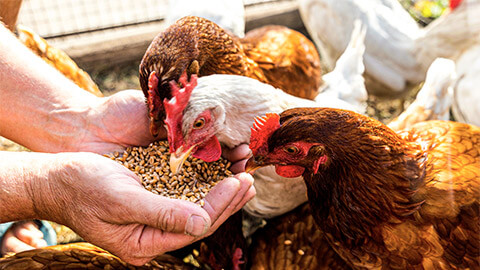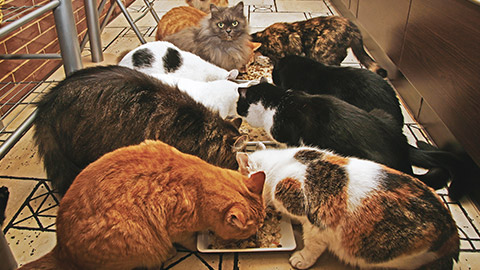Working in the animal care industry it is likely that you will have a number of routine tasks that need to be taken care of on a daily or regularly scheduled basis. Let’s take a look at some of the more common ones.
You will be required to set up housing for different species throughout your career in the animal care industry. Each species will have different requirements or needs. If you are unsure, it is important to ask your supervisor to ensure you are not negatively impacting the animal’s health and well-being.
There are a few things we need to consider when setting up animal housing. These include:
- Principles of animal welfare (we’ll look at Animal Welfare legislation in Module 2 Animal welfare legislation | NZ Government (mpi.govt.nz)).
- Five freedoms of animal welfare Learn more: Five Freedoms vs Five Domains • SPCA New Zealand - Animal Welfare Certified (spcacertified.nz).
- Species.
- Customising the enclosure to suit the needs of the animal at hand.
To do this, we must ask ourselves:
- Is the enclosure big enough for the animal?
- Is the housing secure and escape-proof?
- Is the housing situated in a less stressful area? (Cats housed around other cats and dogs kept away.)
- Is there enough ventilation?
- Is the animal protected from the elements?
- Is there a comfortable resting area?
- Can the animal express normal behaviours?
- Is this cage suitable for the status of disease and infection in this animal?
- Is this cage suitable for the age and mobility of this animal?

Let’s have a look at housing for dogs in a boarding/kennel situation.
We need to ensure the cage is big enough for the animal. Most kennels will have small cages, medium cages, and runs.
We then need to make sure the animal is comfortable. Although animals shouldn’t be left in a soiled cage, sometimes we don’t realise it straight away. Cages should ensure that urine is able to drain away so that the dog is not sitting in it. Blankets and towels are also good options for providing comfort. We also need to ensure the dog has access to fresh water. A stainless-steel bowl can be used for this.
What about cats? What do we need to ensure is included when setting up housing for cats?
- Litter tray (big enough for the cat to step inside and squat).
- Bedding (cats tend to like to hide, so igloos or beds are great)!
- Water bowl with fresh water.
Activity – Hei Mahi
We have just looked at how dogs and cats should be safely and comfortably housed. How about our other companion animals? How do you think rabbits should be housed? Mice or rats? Birds? Choose one of these and share your ideas in the forum using the checklist from the learning content. Remember to read what your classmates say as well.
In New Zealand, the legislation that guides what animals should be fed is the Animal Products Act 1999 and the Agricultural Compounds and Veterinary Medicines Act 1997. Some guidelines to consider when preparing food for animals are:
- Animals must receive appropriate and sufficient food to maintain good health and growth, recognising the special needs of different ages and species.
- Care must be taken to ensure each animal receives the required amount of food, particularly in good housing.
- Food must be stored in a manner that prevents contamination and deterioration. All food must be prepared hygienically.
- Food and water containers must be stable, non-toxic, and easily cleaned and disinfected. Containers must be readily accessible to animals and positioned to avoid spillage or contamination.
- Spoiled food must be removed, and suitable disposal is undertaken.
- Fresh water must be available in sufficient quantity and for sufficient time from appropriate containers, properly and regularly cleaned, as appropriate to the species and type of housing. Ideally, water will be available at all times.
- Depending on the species you are feeding, replicating the natural feeding environment as much as possible is required. This is commonly seen in captive animals.

When feeding animals in the workplace, you must follow the feeding plan provided for the animal. Have a look at your workplace's policies and procedures to get more information on their specific feeding plans and requirements.
A feeding plan is instructions that should provide you with key information such as:
- Feeding methods
- Feeding time/frequency
- Recipe/ingredients/preparation method
- Portion quantities
The feeding plan is generally written by a veterinarian or the senior animal carer or provided by the animal’s owner. Commercial feeding products will also have instructions and recommendations. These instructions and/or recommendations will advise the user on how much to feed the animal based on their weight and how many times a day to feed them.
Case Study
Cat feeding at the SPCA

Emily is feeding the cats in the boarding section on her early morning shift. Cats are crepuscular animals (most active at dusk and dawn), and so the SPCA feeding time factors that in.
Young cats, active cats, unspayed/unneutered, and underweight cats usually need more calories.
Older cats, spayed or neutered cats, inactive cats, and overweight or sedentary cats need fewer calories than younger cats.
Food for each cat is calculated by age, health condition and weight.
First on Emily’s list is Nikita - a young adult cat (3 years old). She’s spayed, weighs 3.8 kilograms and is healthy. Emily is using the feeding plan prepared by the vet, which makes the feeding process straightforward. Emily weighs out the recommended amount of food and gives it to Nikita. She’ll get the same amount of food again in the evening.
Note: spayed = female cats, neutered = males
Activity – Hei Mahi
If Emily didn’t know where to find the feeding plan for Nikita, there is plenty of advice available online about feeding cats.
- Use this calorie counter to work out how many calories Nikita needs. MER Calculator for Cats | purinainstitute
- Look up some different brands of cat food available, both dry and wet. How much food would Emily need to give her, depending on the type and brand of the food?
- Is there a lot of difference in recommended amounts across the different brands?
Separate food and water bowls must be provided and must be suitable for the animal’s habitat. You should always take into consideration the accessibility for the animal and the carer as they will need to replenish the supply.
When choosing a food bowl for the animal, factors you should consider include the following:
- Rounded edges to prevent cuts and scrapes.
- Non-spill water dishes.
- Non-toxic manufacturing materials.
- Stainless steel dishes are ideal for cleaning and disinfecting. Plastic dishes retain odour.
Safety around animals during food preparation and delivery is extremely important. There are certain hazards that you must be aware of and take measures to reduce. When undertaking feeding and watering tasks, be aware of the fact that hungry animals can be quite excited, anxious, possessive, and sometimes aggressive, which may or may not be the case during normal interactions.
Let’s do a quick recap of some of the hazards we covered earlier in this module. Can you recall them? Take a moment to remind yourself, then check your answers by clicking on the + symbol.
- Bites
- Scratches
- Kicks, crush injuries, head butting, charging, or trampling
- Zoonotic diseases
Before approaching an animal to undertake feeding and watering duties, always ensure you have prepared the area and secured all animals. Observe the animals and their behaviour. Reassure the animal and use a calm voice to talk to the animal. If required, use appropriate restraint or place the food in an empty cage first before placing the animal in the cage. Wear appropriate personal protective equipment.
In the workplace, recording of feeding habits and abnormalities is required. This is vital to ensure the health and well-being of the animals in your care. This may be done on a computer file, a cage card, or as a part of the feeding plan. The information that should be observed and recorded includes:
- Any uneaten food from the previous feed.
- Consumption.
- Urine, faeces, and vomit.
- Type and amount of food and water.
- General observations of behaviour, demeanour, and health.
If an animal is not eating, losing weight, or displaying signs of pain or discomfort, you should record this and report it to your supervisor.
So, what does the feeding and watering process look like?
- Wash your hands and apply PPE.
- Familiarize yourself with the animal’s feeding plan.
- Prepare the area and ensure it is free from hazards.
- Choose an appropriate bowl for the food, ensuring it is clean.
- Prepare the food according to the feeding plan, ensuring that the food is correctly weighed or measured. Check the food is not spoiled and ready to eat.
- Observe the animal’s behaviour.
- Deliver the food safely to the animal based on your observations of their behaviour.
- Replenish the water.
- Observe the animal and record and/or report any findings.
- Clean up the preparation area and ensure all food products are stored correctly.
Activity – Hei Mahi
So what about looking after companion animals at home? What should Kai feed their hungry rabbits Freya and Ravenna, how much should they feed them, and what should they look out for/observe when feeding them? Use the information about feeding that we have just covered and share your ideas in the forum.
Enrichment is used and provided to animals to enhance their environment and encourage natural behaviours and interactions with humans, other animals, and their surroundings. There are different types of enrichment strategies. These include:
Food-based enrichment
For example, putting the animal’s food in a Kong or similar toy. These toys encourage the animal to play and move around until the food falls out of the toy. Another example, especially for captive animals, is to hide the food around the enclosure to encourage foraging.
Structural enrichment
For example, adding in objects such as swings or climbing towers.
Olfactory enrichment
For example, smearing odours on objects and trees within the enclosure.
Cognitive enrichment
For example, activities that encourage problem-solving. This could include puzzles or puzzle feeders.
Social enrichment
For example, introducing species of the same kind or different species that they would normally encounter in the wild (as long as this doesn’t pose a risk to the animal’s safety).
Human-interaction enrichment
For example, training and trust-building exercises.
It is extremely important to consider the age, mobility, species, and safety of the animal when developing or implementing enrichment strategies.
Activity – Hei Mahi
Choose a companion animal (cat, dog, rodent, rabbit, bird) and design an enrichment activity for it. You may choose to add images or diagrams to illustrate your idea. Share your enrichment activity in the forum. Don’t forget to like and comment on the ideas of your coursemates!
Congratulations!
You’ve made it to the end of the learning content for this topic. By now you should have started on your assessment. Good luck and do your best with it! Here’s one last learning activity for you to check how well you are progressing.

What was covered?
The purpose of this module has been to give you an overview of what the animal care industry looks like. At the start of this module we discussed:
- Possible career options and opportunities for further study
- The skills, attributes, roles and responsibilities of animal care workers
- What the work place looks like, including hazards to be aware of
Then we moved on to the important topic of communication. There was a lot to mention here including:
- Spoken skills
- Written skills
- Telephone skills
- Listening skills
- Communication styles
- Interpersonal skills
- Workplace behaviours
- Ethics
Our next important topic was about the Māori culture and the importance of Te Tiriti o Waitangi. We touched on:
- The 3 principles of the Treaty
- Key Te Reo words for the animal care workplace
- Tikanga and Te Ao Māori
Our final topic looked at the day to day activities for the animal care workplace:
- Cleaning cages
- Feeding and watering animals
- Enrichment for animals
Hei Mahi – Activity
The best way to remember something is to make your own notes. You will be able to keep them to refer back to once your study with us has been completed. Download this worksheet to help you summarise what you think is the most important information to remember from Module 1.
If you have additional questions for your tutor or classmates about the content in Module 1 you can ask them in this forum thread.
Forum Task:
CONTENT TYPE: Forum
Heading: Activity
Forum Name: Forum
Thread Name: Module 1 General Questions
LMS Instruction: If you have additional questions for your tutor or classmates about the content in Module 1 you can ask them in this forum thread.
Forum Landing Page Instruction: If you have additional questions for your tutor or classmates about the content in Module 1 you can ask them in this forum thread.
What can you expect?
The assessment for Module 1 is made up of small case studies. Each case study will have between two (2) and five (5) questions to answer. There is an example for you below.
You will type your answers directly into the LMS. You will be able to save a draft of your assessment in the LMS and work on it until you are ready to submit.
What is being assessed?
All of the assessments for this programme have learning outcomes. This is the learning outcome for the Module 1 assessment:
Discuss approaches to build positive interpersonal relationships and maintain ethical behaviour in an animal care and welfare setting.
All tasks in this assessment will be testing:
- that you understand how to build positive interpersonal relationships
- that you know how to maintain ethical behaviour
How will you be graded?
To pass this assessment you will need to get 80% of the questions correct. You will be able to attempt the assessment three (3) times if you do not achieve 80% on your first try.
There’s no need to hurry through your assessment. Take your time!
Practice Questions
Here’s an example case study and four (4) related questions. An ‘achieved’ and a ‘not achieved’ learner answer has been provided for each question so that you can understand the length and quality of answer to write. Click the + buttons to reveal how each person did.
Case Study Scenario: Taylor works at a local animal shelter and is training a new team member, Jordan. Taylor notices Jordan is struggling with handling one of the shelter’s dogs, Max, who has behavioral challenges. Jordan seems frustrated, and Taylor is considering how to offer support and maintain a positive team environment.
Question 1
What is one approach Taylor could use to build a positive interpersonal relationship with Jordan in this situation? (Write two to three sentences)
This is Maia’s answer:
Taylor could offer constructive feedback by acknowledging Jordan’s effort, then sharing a few handling techniques that have worked well with Max. By showing empathy and offering guidance, Taylor can help Jordan feel supported and valued, which will likely foster a positive working relationship.
This is Dillon’s answer:
Taylor should just tell Jordan to work harder and try to figure it out. If Jordan is good enough for the job, they will eventually learn to handle Max on their own.
Maia’s answer is a better match with the learning content, so the tutor marked her as ‘achieved’. Dillon’s answer does not match with the learning content, so the tutor marked him as ‘not achieved.’ Dillon will need to re-do his answer.
Question 2
What could Taylor do to support Jordan in maintaining ethical behavior with Max? (Write two to three sentences)
This is Joseph’s answer:
Taylor should warn Jordan that if they can’t handle Max, they might be reassigned to cleaning tasks instead. This will motivate Jordan to improve their skills with Max without needing further help.
This is Anaru’s answer:
Taylor could remind Jordan of the shelter’s training guidelines for handling dogs like Max and discuss how these guidelines ensure the dog’s welfare. By reinforcing these standards, Taylor helps Jordan uphold ethical practices, showing respect for Max’s needs and reducing the risk of frustration-driven errors.
Anaru’s answer is a better match with the learning content, so the tutor marked him as ‘achieved’. Jospeh’s answer does not match with the learning content, so the tutor marked him as ‘not achieved.’ Joseph will need to re-do his answer.
Question 3
How can Taylor provide feedback to Jordan to encourage a positive working environment? (Write two to three sentences)
Bradon’s answer:
Taylor might start by complimenting Jordan on what they did well, then suggest one specific area for improvement. For example, Taylor could say, “You’re doing great with keeping Max calm; try using a gentler tone next time for better results.” This approach encourages growth and keeps morale high.
Leona’s answer:
Taylor should just point out what Jordan did wrong to prevent similar mistakes in the future. This would make it clear to Jordan that they need to improve quickly to keep up with the team’s standards.
Bradon’s answer is a better match with the learning content, so the tutor marked him as ‘achieved’. Leona’s answer does not match with the learning content, so the tutor marked her as ‘not achieved.’ Leona will need to re-do her answer.
Question 4
What should Taylor avoid to maintain a supportive and ethical team environment? (Write two to three sentences)
Willow’s answer:
Taylor should avoid dismissive comments or negative language that could discourage Jordan. It’s important to keep the focus on constructive guidance rather than blame, as this helps maintain a respectful and ethical work environment where Jordan feels motivated to learn and improve.
Maki’s answer:
Taylor shouldn’t waste time sugar-coating feedback. If Jordan isn’t performing well, it’s better to be direct, even if it means saying something harsh, to ensure they understand the seriousness of the role.
Willow’s answer is a better match with the learning content, so the tutor marked her as ‘achieved’. Maki’s answer does not match with the learning content, so the tutor marked her as ‘not achieved.’ Maki will need to re-do her answer.
You are now ready to give the assessment a go. Good luck! You’ve got this! See you in the next module.
